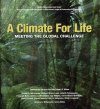Art / Photobook
By: Cristina Goettsch Mittermeier(Editor), Russell A Mittermeier(Author), Michael Totten(Author), Laura Ledwith Pennypacker(Author), Frederick Boltz(Author), Guy F Midgley(Author), Carlos Manuel Rodríguez(Author), Glenn Prickett(Author), Claude Gascon(Author), Peter A Seligmann(Author), Olivier M Langrand(Author), Harrison Ford(Foreword By), Edward O Wilson(Foreword By)
359 pages, colour photos, colour illustrations
![A Climate For Life A Climate For Life]()
Click to have a closer look
About this book
Contents
Customer reviews
Related titles
About this book
This lavishly illustrated book focuses on the global challenge of climate change and what we can do now and in the coming decades to dramatically reduce risks to human health, economic prosperity, and the planet’s irreplaceable biodiversity. In particular, it looks at the threats to biodiversity and human survival, the abundance of nature-based and technological solutions now available, and the need for rapid and continuous action on all fronts. With a comprehensive introduction written by a distinguished group of scientists led by Russell A. Mittermeier, President of Conservation International, and a foreword by Harrison Ford and Edward O. Wilson, A Climate for Life focuses on some of the most important challenges facing life on our planet.
A Climate for Life provides a message that places the risk of climate destabilization by humans in context by clarifying how its causes, impacts, and solutions derive from the intricate and delicate balance between modern society and the natural world. The expert authors examine a wide range of climate issues, with particular emphasis on how natural environments can contribute to and benefit from measures to address climate change, while the world-renowned photographers provide breathtaking evidence for the urgency of our cause.
Ten chapters cover the foremost climate issues, including how the world’s forests, important as carbon sinks, are being rapidly deforested; how both avoided deforestation and reforestation are key actions for stabilizing the global climate; how areas of threatened biodiversity are adapting to climate change, some more successfully than others; what role our oceans play as climate change raises temperatures globally; the impact on freshwater systems; what happens globally as polar areas warm and melt; and how humans face mounting risks from an overheated atmosphere, particularly in developing countries.
And yet there is considerable hope. Incredible technological innovations are moving us towards zero net energy buildings, zero emission cars and factories, global-scale harnessing of competitive wind and solar power and other renewable energy options, thus reducing our dependence on fossil fuels. These reductions, in conjunction with strategies to prevent deforestation and land degradation, offer economically and ecologically attractive means of stabilizing the Earth’s climate. Conservation efforts will buffer protected areas and ensure that habitats are preserved and species can migrate to adapt, and developing countries will be able to ensure sustainable livelihoods for their citizens without jeopardizing their most precious resources.
Powerfully illustrated with 175 photographs by some of the world’s foremost photographers, the book graphically illustrates the concepts in each chapter. Additionally, ten photographers are featured as “Eyewitnesses to Change.” Their firsthand experiences in the field are documented through a portfolio of their images and firsthand account of their experiences. The list of noted photographers includes Frans Lanting, James Balog, and Joel Sartore, among others.
We have the capacity to destroy or to safeguard the biodiversity on our planet. It is within our grasp to adapt to the conditions we have created and to mitigate our impact on the future. Now is the time to engage our intellect, develop solutions, and implement the actions needed to ensure a stable climate for the future – A Climate For Life.
Contents
Foreword - Harrison Ford and Edward O. Wilson 11
Introduction 19
I: Mitigation - Mitigating climate change 43
Chapter 1. Energy efficiency 49
Eyewitness to Change: Sarah Leen 65
Chapter 2. Renewable energy 71
Chapter 3. Biofuels 93
Eyewitness to Change: Joel Sartore 115
Chapter 4. Forest Conservation 121
Eyewitness to Change: Tim Laman 143
Eyewitness to Change: Daniel Beltrá 149
Chapter 5. Reforestation and agroforestry 155
Eyewitness to Change: Cristina Mittermeier 177
II: Adaption - Adapting to climate change 183
Chapter 6. Terrestrial biodiversity 189
Eyewitness to Change: Frans Lanting 207
Chapter 7. Freshwater biodiversity 217
Eyewitness to Change: Michael Forsberg 235
Chapter 8. The role of oceans 247
Eyewitness to Change: Paul Nicklen 267
Chapter 9. Human dimensions 277
Eyewitness to Change: John Stanmeyer 297
Chapter 10. Tipping points 303
Eyewitness to Change: James Balog 319
Conclusion: A call to action 325
References 342
Glossary 350
List of contributors 355
Lead authors 356
Featured photographers 358
Customer Reviews
Art / Photobook
By: Cristina Goettsch Mittermeier(Editor), Russell A Mittermeier(Author), Michael Totten(Author), Laura Ledwith Pennypacker(Author), Frederick Boltz(Author), Guy F Midgley(Author), Carlos Manuel Rodríguez(Author), Glenn Prickett(Author), Claude Gascon(Author), Peter A Seligmann(Author), Olivier M Langrand(Author), Harrison Ford(Foreword By), Edward O Wilson(Foreword By)
359 pages, colour photos, colour illustrations
































![Primatas do Amapá: Guia de Identificação de Bolso [Primates of Amapá: Pocket Identification Guide]](http://mediacdn.nhbs.com/jackets/jackets_resizer_medium/18/181441.jpg?height=150&width=66)






![Grenouilles de Madagascar du Genre Mantella: Guide d'Identification de Poche [Frogs of Madagascar, Genus Mantella: Pocket Identification Guide]](http://mediacdn.nhbs.com/jackets/jackets_resizer_medium/18/181535.jpg?height=150&width=67)
